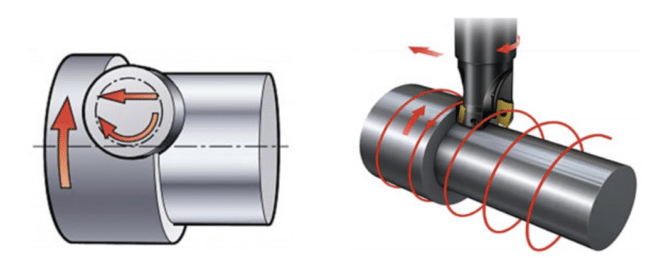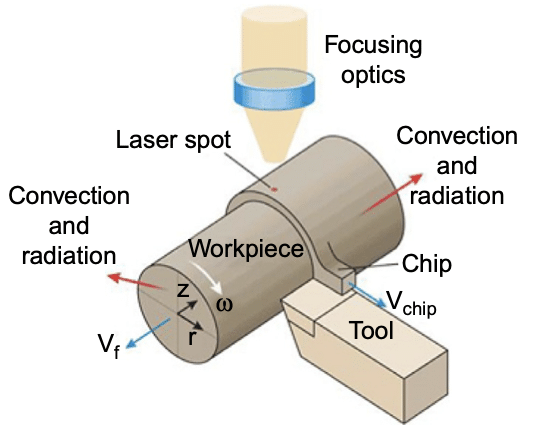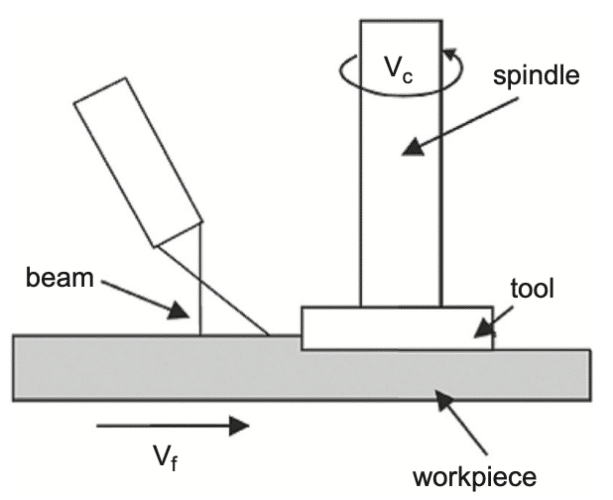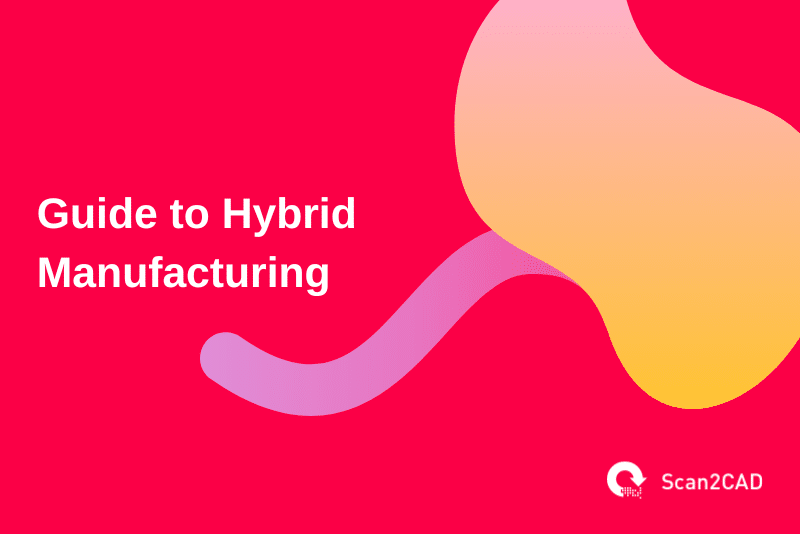Machining processes have continuously evolved. Part of this evolution has involved combining individual processes or using various active energy sources or additives in a complementary role to improve the properties and capabilities of the individual processes. Thus, hybrid manufacturing came to be. This type of manufacturing combines various manufacturing techniques either simultaneously or sequentially, including removal processes (subtractive machining), non-removal processes (transformative machining), and additive machining.
This ultimate guide will discuss what hybrid manufacturing is, the various types and categories of hybrid manufacturing, the advantages and limitations of each type, and what to consider if and when you want to implement hybrid machining/manufacturing processes. Let’s get started.
Table of Contents
Understanding Hybrid Manufacturing
There are several definitions of hybrid manufacturing. The first, put forth by the International Academy for Production Engineering, defines it as processes based on “the simultaneous and controlled interaction of process mechanisms and/or energy sources or tools having a significant effect on the process performance.” The second definition describes hybrid manufacturing as a combination of additive and subtractive methods.
More broadly, when considering the definition of a hybrid process, hybrid manufacturing is a manufacturing approach that combines either two or more manufacturing processes belonging to distinct categories of technologies or an active external energy source and a machining process that interact and influence each other, either simultaneously or sequentially, within the same machine.
The interaction of processes within the same platform or machine indicated that these processes are controlled. That feeds into the first definition above. Similarly, the requirement that two or more processes must belong to different categories of technologies supports the second definition. Thus, we can consider the broader third definition as the all-encompassing definition of hybrid manufacturing.
Hybrid manufacturing can combine (either simultaneously or successively) the following processes:
- Additive and subtractive manufacturing processes
- Two or more subtractive manufacturing processes
- Two or more additive manufacturing processes
Categories of Hybrid Manufacturing Processes
There are two main types or categories of hybrid manufacturing:
- Combined hybrid manufacturing
- Assisted hybrid manufacturing
In both categories, interactions involving heating, melting, mechanical abrasion, evaporation, dissolution, and plastic flow occur. These interactions change not only the physical and chemical conditions of the processes but also the properties of the workpiece material. These interactions can largely be grouped into mechanical, thermal, and chemical and electrochemical. Therefore, the development of hybrid manufacturing processes involves using these different interactions, either simultaneously or in succession.
Combined Hybrid Manufacturing
In combined hybrid manufacturing, all constituent processes are applied directly and simultaneously to remove or add material from a workpiece. Examples of hybrid manufacturing processes that fall into this category are:
- Electrochemical Discharge Machining (ECDM)
- Electrochemical Arc Machining (ECAM)
- Electrochemical Grinding (ECG)
- Abrasive Electrochemical Honing (AECH)
- Turn-milling
Assisted Hybrid Manufacturing
IIn assisted hybrid manufacturing, one process is responsible for adding or removing material, while the other plays only an assistive role. The main process is, therefore, referred to as the primary process. By extension, this means the process that plays an assistive role is known as the secondary process.
One example of assisted hybrid manufacturing in action is the use of a machining process, such as grinding, to remove excess materials following 3D printing, an additive manufacturing process. This is known as abrasive-assisted hybrid manufacturing. Examples of assisted hybrid manufacturing processes include:
- Abrasive-assisted hybrid manufacturing, e.g., abrasive-assisted Electrical Discharge Grinding (AEDG), Abrasive-assisted Electrical Discharge Machining (AEDM), and abrasive-assisted electrochemical machining
- Vibration-assisted hybrid manufacturing, e.g., vibration assisted Electrochemical Machining, vibration-assisted Electrical Discharge Machining, and vibration-assisted laser beam machining
- Laser-assisted hybrid manufacturing, e.g., laser-assisted electrochemical machining, laser-assisted turning, laser-assisted electro-discharge machining, laser-assisted etching, laser-assisted water jet machining, and laser-assisted oxide film lithography
- Plasma-assisted hybrid machining, e.g., plasma-assisted turning (PAT)
- Magnetic field-assisted hybrid manufacturing, e.g., magnetic field-assisted electrical discharge machining and magnetic field-assisted electrochemical machining
- Fluid-assisted polishing hybrid manufacturing, e.g., abrasive waterjet machining and electrolytic in-process dressing (ELID) grinding
- External electric field-assisted hybrid manufacturing, e.g., electric-field assisted direct writing (EADW), which is a type of metal 3D printing
Types of Hybrid Manufacturing Processes
1. Electrochemical Discharge Machining
Electrochemical discharge machining, also referred to as electrochemical spark machining, is an advanced hybrid manufacturing process. It comprises two machining techniques: electrochemical machining and electro-discharge machining. For this process to work, there must be an electrochemical cell that comprises two electrodes: the tool and auxiliary electrodes, both dipped in electrolyte. In this process, the tool is connected to the negative terminal of a pulsed DC power supply, while the positive terminal is connected to the auxiliary electrode. The workpiece is not connected to any terminal.
Electric current flows through the cell when an external potential is applied between the electrodes. This generates gas bubbles because of electrochemical reactions, with a layer of gas bubbles forming around the cathode (tool). When the applied voltage exceeds a certain value, electric sparks appear across the gas bubble layer at the electrode-electrolyte surface on the smaller electrode. This phenomenon is known as the electrochemical discharge.
The electrochemical discharge mechanism removes material from a workpiece by melting and vaporization if and when the workpiece is placed near the sparks/discharges.
Holmarc makes electrochemical discharge machining systems like the HO-ECDM-01, although its machines have a small footprint, as they are designed for laboratory use. If you are looking for industrial-grade ECDM systems, check out KRC Machine Tool Solutions, which manufactures custom ECDM machines.
Advantages of Electrochemical Discharge Machining
- It can be machine electrically non-conducting materials like glass, alumina, composites, and ceramics
- Electrochemical discharge machining can machine parts whose dimensions range from meso (0.1mm to 5mm) to micron scale (it can be used in micro-machining)
- It can machine chemically inert materials
- The process can generate non-circular or complex-shaped cavities
Limitations of Electrochemical Discharge Machining
- The process produces a poor surface finish
- It results in tool wear due to electrochemical dissolution
- Electrochemical discharge machining can only remove material at shallow depths
2. Electrochemical Arc Machining
Electrochemical arc machining, or ECAM, combines electrochemical machining (ECM) and electro-discharge machining (EDM). It specifically applies pulsed DC voltages between a tool (the cathode or negative electrode) and a workpiece (the anode or positive electrode) separated by a thin film of electrolyte to produce electrochemical dissolution and electro-discharge erosion.
Advantages of Electrochemical Arc Machining
- It has a very high metal removal rate: between 5 to 40 times greater than ECM and EDM
- Electrochemical arc machining achieves a better surface finish
- It leads to less tool wear
- The heat-affected zone is less than in ECM and EDM
Limitations of Electrochemical Arc Machining
- Its use is restricted to electrically conductive material
- The accuracy is reduced compared to ECM and EDM
3. Electrochemical Grinding (ECG)
Electrochemical grinding combines conventional grinding with electrochemical machining. However, it differs significantly from conventional grinding, which uses a grinding wheel to which abrasives have been bonded. This abrasive-bonded grinding wheel induces a cutting force on the workpiece, generating heat and removing material. However, this is not the case when it comes to ECG.
In ECG, a metallic wheel is used in place of the abrasive-bonded wheel. The metallic wheel does not contact the workpiece, meaning it does not induce any cutting force. Instead, it acts as a cathode and rotates above the anodic workpiece, with both the wheel and workpiece immersed in an electrolyte.
This process is particularly effective for producing fragile parts, thin-walled tubes, tungsten carbide cutting tools, and machining parts made from materials that are difficult to cut, among others.
Advantages of Electrochemical Grinding
- It produces a flat surface with excellent quality
- The process does not lead to distortion or stress development on the workpiece because of the lack of contact
- It eliminates grinding burrs
- Electrochemical grinding has a high material removal rate
- The rotating wheel has a longer service life
- It produces workpieces with narrow tolerances
Limitations of Electrochemical Grinding
- It is slower and, therefore, less efficient than conventional grinding
- The use of electrochemical grinding is restricted to electrically conductive materials
- It requires a higher capital investment than conventional grinding machines
- Electrochemical grinding machines have a higher maintenance cost
- The electrolyte can corrode the workpiece and tools
- It requires regular filtering as well as disposal of the electrolyte
4. Abrasive Electrochemical Honing
Abrasive electrochemical honing combines an abrasive and anodic dissolution in an electrolyte to produce smooth internal surface finishes. Although it uses abrasives, most of the material is removed by dissolution, unlike conventional honing.
Advantages of Abrasive Electrochemical Honing
- Abrasive electrochemical honing is faster than conventional honing as it combines mechanical erosion with dissolution for material removal
- It achieves extremely good surface finishes, which do not have micro-scratches
- The process achieves better dimensional tolerances than conventional honing
- The mechanical action improves the fatigue strength of the finished workpiece because it produces compressive residual stress
Limitations of Abrasive Electrochemical Honing
- Its use is restricted to electrically conductive material
5. Abrasive-Assisted Electrical Discharge Machining
Abrasive-assisted electrical discharge machining was developed to solve some limitations of the conventional EDM. Ordinarily, the EDM process removes material using a series of spark discharges. However, its use often results in poor surface quality, a relatively low material removal rate, and tool wear from material vaporization. In abrasive-assisted EDM, the properties of the dielectrics are modified by introducing additives like metal powders and abrasives. These additives have been shown to improve machining performance and increase efficiency.
But what function do the additives play? Adding the metal powder or the abrasive decreases the electrical resistivity of the dielectric and expands the spark gap. The abrasives also help remove molten material from the craters, translating to better material removal (flushing). The abrasive-assisted EDM can also achieve a mirror finish, but this result depends on the optimal settings of electrode polarity and pulse parameters.
Advantages of Abrasive-Assisted Electrical Discharge Machining
- It takes a shorter time to machine the materials compared to conventional EDM
- Abrasive-assisted EDM achieves a better surface finish
- By increasing the spark gap, the metallic (conductive) abrasives reduce tool wear
- Semiconductive abrasives increase material removal depth as they reduce the spark gap
Limitations of Abrasive-Assisted Electrical Discharge Machining
- Semiconductive abrasives increase tool wear
- The process requires you to make various modifications (e.g., the type of abrasive, electrode polarity, and pulse parameters) to achieve certain finishes, which can be overwhelming
6. Turn-Milling Process
Turn-milling combines two conventional machining processes: turning and milling. In this process, both the tool and the workpiece rotate. As a result, it is used to create complex and unconventional shapes, which cannot be generated in separated processes.

Illustration of Turn-Milling Process (source)
Advantages of Turn-Milling Process
- It increases productivity
- The turn-milling process produces better surface finish
- It reduces tool wear, thus improving tool life
- The process has a high material removal rate
- It is used to create complex eccentric shapes
Limitations of Turn-Milling Process
- There are many parameters that affect the process, impeding optimisation
7. Abrasive-Assisted Electrochemical Machining
In abrasive-assisted electrochemical machining, abrasive grains are added to a high-velocity-flowing electrolyte to prevent the formation of a thin oxide layer on the workpiece’s surface. In conventional ECM, the film, which is electrically non-conductive and sticky, prevents smooth machining. Thus, the abrasive grains prevent the formation of the film, accelerating the anodic dissolution of ECM. The abrasives also remove minor burrs from the surface of the workpiece.
Advantages of Abrasive-Assisted Electrochemical Machining
- The grains increase the efficiency of the ECM process
Limitations of Abrasive-Assisted Electrochemical Machining
- The abrasive grains may cause tool wear and can wear out the machine parts
- The abrasives modify the properties of the electrolyte
8. Vibration-Assisted Mechanical Machining
Mechanical machining methods include drilling, grinding, turning, and milling. They use a cutting tool to remove material from a workpiece. The tool must make contact with the workpiece, with a cutting force subsequently applied to induce material removal. Introducing vibration creates movement similar to hammering, which can be disadvantageous as it can generate cracks. However, it reduces the machining forces by ensuring the cutting tool intermittently loses contact with the workpiece at a specified amplitude and frequency.
Examples of vibration-assisted mechanical machines are the OptiSonic CNC Ultrasonic Machining Centers, which combine mechanical machining methods with ultrasonic vibration to reduce the force applied to both the tool and workpiece. These machines can perform ultrasonic milling, ultrasonic grinding, and ultrasonic core drilling.
Advantages of Vibration-Assisted Mechanical Machining
- The vibrations reduce the cutting or drilling forces
Limitations of Vibration-Assisted Mechanical Machining
- Vibration-assisted milling and grinding are less common because they would require complicated machine architecture and structure
9. Vibration-Assisted Electrochemical Machining
The vibrations help remove the thin oxide layer resulting from electrochemical passivation. It also induces waves within the gap between the workpiece and the tool, aiding in flushing out gas bubbles. By creating better flushing, the vibrations help control the machining process.
Advantages of Vibration-Assisted Electrochemical Machining
- The vibrations improve the reactions that remove material
- They decrease the rate of formation of the oxide film
- The vibrations increase machining efficiency
Limitations of Vibration-Assisted Electrochemical Machining
- There are multiple parameters to consider, which can complicate the process
10. Vibration-Assisted Electrical Discharge Machining
Vibration-assisted electrical discharge machining introduces small-amplitude and specific-frequency vibrations to the electrodes or dielectric fluid. The vibrations help improve machining efficiency by improving flushing.
Advantages of Vibration-Assisted Electrical Discharge Machining
- Ultrasonic vibration-assisted EDM improves the surface finish and fatigue behavior
- Vibration increases machining efficiency, as it improves flushing
Limitations of Vibration-Assisted Electrical Discharge Machining
- Vibrations of specific amplitude and frequency are required to achieve optimal results
11. Vibration-Assisted Laser Beam Machining
Laser beam machining removes material from workpieces through thermal action. It can machine any material regardless of its mechanical properties or electrical conductivity. However, the process has a few drawbacks arising from the use of heat energy. Laser beam machining produces thermal damage and cracks. It also melts materials or causes the re-deposition of molten metal. To overcome these limitations, vibration is used in an assistive role. Vibration plays several significant roles. It prevents surface oxidation and the formation of a re-deposition layer.
Advantages of Vibration-Assisted Laser Beam Machining
- It improves the surface finish
- Vibration increases heat transfer, producing a cooling effect that reduces the chances of particles being deposited and sticking to surfaces
Limitations of Vibration-Assisted Laser Beam Machining
- There are various types of vibration that you can deploy, e.g., ultrasonic vibration and mechanical vibration, each producing different results
12. Laser-Assisted Mechanical machining
The laser-assisted mechanical machining (LAMM) process uses a defocused laser beam to pre-heat and soften the workpiece during conventional milling, drilling, or turning. LAMM is used on materials whose high strength and low thermal conductivity or high strength and heat resistance make them difficult to machine. Such materials require high cutting forces and temperature when machined using conventional manufacturing methods. However, this often leads to short tool life.
Thus, using the laser, a heat source, softens the workpiece, changing the deformation behavior. It causes the material to be ductile instead of brittle. LAMM methods are used to machine materials such as titanium alloys, nickel superalloys, and ceramics, which, ordinarily, are difficult to machine.
There are several types of laser-assisted mechanical machining methods:
- Laser-assisted turning: In this process, a laser beam and a cutter remain stationary as the workpiece rotates around an axis perpendicular to the tool and source of the laser beam.
- Laser-assisted milling: In this process, the cutter and laser beam move along a pre-defined toolpath while the workpiece remains stationary

Illustration of Laser-Assisted Turning (source)

Illustration of Laser-Assisted Milling (source)
Advantages of Laser-Assisted Mechanical Machining
- Laser-assisted mechanical machining reduces tool wear
- The processes decrease the cutting forces required
- Laser-assisted turning has a high material removal rate
- Laser-assisted turning results in a good surface finish
Limitations of Laser-Assisted Mechanical Machining
- It is important to accurately and appropriately position and orient the beam on the workpiece, which requires great attention to detail
13. Laser-Assisted Advanced Machining
There are several laser-assisted advanced machining methods, including:
- Laser-assisted waterjet machining: In this process, the laser softens the workpiece material, thus decreasing the cutting forces required.
- Laser-assisted etching: This process is used to etch ceramics, high polymers, metals, and semiconducting materials. The heat energy from the laser does not melt the materials. Rather, it supports the motion of the dissolution of materials.
- Laser-assisted electric discharge machining: In laser-assisted EDM, the laser is used to pre-machine the basic part features, e.g., creating a hole or groove. EDM is then used to remove defects that result from the heat from the laser beam. EDM also produces a better surface finish.
- Laser-assisted electrochemical machining: This process couples a laser with electrochemical machining to enhance the dissolution process wherever the laser beam hits the workpiece.
Advantages of Laser-Assisted Advanced Machining
- Laser-assisted EDM achieves a superior surface finish
- The laser beam reduces the cutting forces
- The processes make it easy to machine difficult-to-machine materials
- It solves some of the main drawbacks of individual processes like laser beam machining, EDM, waterjet machining, and more
Limitations of Laser-Assisted Advanced Machining
- Laser-assisted machining involves multiple parameters, including the machining parameters, properties of the workpiece, and laser parameters, which make it challenging to optimize the process
14. Directed Energy Deposition and Mechanical Machining
This hybrid manufacturing method combines directed energy deposition (DED), an additive manufacturing process, with subtractive mechanical machining operations such as milling or turning. DED is a broad 3D printing technology that covers various sub-technologies, including laser metal deposition (LMD), direct metal deposition, laser-engineered net shaping, and more.
In DED, energy is focused on a specific area, heating the metal powders. Upon melting, the material is deposited onto the surface, where it solidifies. (If a laser generates the energy, then that process is called LMD.) Subsequent mechanical machining methods are employed to remove excess material from the part, resulting in a smooth surface finish.
Hybrid manufacturing systems that combine additive and subtractive manufacturing processes can be used to repair damaged or worn parts, such as turbine blades with surface cracks or cavitation pits. Additionally, they can be used as part of the rapid prototyping process.
Hybrid Manufacturing Technologies
1. Hybrid 3D Printing
3D printing technology, particularly DED, is perhaps the most commonly discussed hybrid manufacturing technology. This is because most industrial systems that can perform DED can also complete other operations. A hybrid 3D printer can, for instance, perform such operations as laser metal deposition, hardening, subtractive machining, and grinding all in one machine.
OKUMA’s MU-8000V LASER EX and DMG MORI’s LASERTEC 3000 DED Hybrid are examples of 3D printing hybrid machines. The former performs laser metal deposition, hardening, subtractive machining, and grinding in one machine. The latter, on the other hand, performs additive manufacturing (DED) as well as turning or milling.
2. CNC Machines
When you think of machines that perform hybrid manufacturing, you might picture sophisticated systems capable of undertaking more than one machining process. While this is true for CNC multitasking machines, that description does not apply to the entire hybrid manufacturing domain. Some systems are just CNC machines that can only perform a single machining process but which have been modified. Take the example of an abrasive-assisted electrical discharge machining system.
In a study investigating the optimal machining conditions in abrasive-assisted EDM of a titanium alloy, researchers added silicon carbide particulates to commercial-grade EDM oil, which is ordinarily used as a dielectric. They used the CMAX S645, a dedicated advanced CNC die sinker electrical discharge machine. Similarly, to convert a dedicated waterjet machine into a hybrid machining system, simply mix suitable abrasives with the water.
3. CNC Multitasking Machines
Other machines have built-in multitasking capabilities. They can perform two or more machining operations, either simultaneously or in succession, in the same system without requiring manual intervention.
These machines automatically handle and load/unload parts from the initial to the final operation. Their multitasking capabilities save time in job setting, scheduling, and material handling. Moreover, the CNC multitasking machines improve part accuracy, lower the cost required to manufacture parts, and reduce unnecessary (non-value added) manufacturing time.
But that’s not all. By eliminating the need for multiple dedicated CNC machines, multitasking systems reduce the required floor space, lower the power consumption, and increase throughput. However, compared to dedicated machines, multitasking systems are more expensive and harder to maintain.
Advantages of Hybrid Manufacturing
Hybrid manufacturing, in general, has the following advantages:
- It produces a better surface finish
- Hybrid manufacturing, in most cases, reduces the machining time
- The processes reduce tool wear, thus improving the tool life
- Hybrid manufacturing operations have a higher material removal rate
- The hybrid processes solve the shortcomings of dedicated processes
Limitations and Solutions of Hybrid Manufacturing
We have elaborated some of the individual limitations of hybrid manufacturing processes earlier, but more broadly, hybrid manufacturing is beset by the following challenges:
- Some hybrid manufacturing systems can be expensive and harder to maintain than dedicated systems
- Vibration-assisted processes can decrease the machining accuracy because of the influence of the vibratory movements
- Thermal-assisted processes can increase the number of cracks and burrs
While these limitations and challenges can delay the progress of manufacturing activities, they are not insurmountable. Experts recommend selecting proper parameters based on suitable process-material interactions to prevent such issues as poor accuracy and undesirable surface finishes as well as heat-affected zones (HAZ) with microcracks.
This recommendation hinges on the fact that hybridizing multiple processes using various thermal, chemical, or mechanical interactions is an extremely complex practical and scientific issue. This hybridization applies to various aspects, including the machine tool (and such properties as the accuracy of both the control systems and feed drives and thermal stability), the process itself, and process monitoring.
Implementing Hybrid Manufacturing
Currently, manufacturing best practices lean towards processes that increase productivity, efficiency, and flexibility while maintaining exemplary quality. Given the advantages of hybrid manufacturing, it can be tempting to want to procure a hybrid manufacturing system. But such a machine may not be suited for your shop’s or company’s needs.
Hybrid manufacturing systems are preferred in manufacturing cycles with multiple stages, each involving a different manufacturing machine. This is quite the norm when machining objects with complex features and shapes. In such cases, the part must be unloaded, handled, loaded, and positioned in a different vice whenever you want to use a different machining process.
From a productivity perspective, these steps significantly increase the production time. Yet, they are not value-adding. Over time, the cost associated with this non-value-added manufacturing time compounds significantly. Additionally, the steps can be a source of inaccuracies and inefficiencies. And, of course, multiple dedicated machines will require a larger space. Given such a scenario, it is advisable to implement hybrid manufacturing.
Conclusion
Hybrid manufacturing has evolved as a product of continuous advancements in machining processes. Driven by the pursuit of enhanced efficiency, productivity, and flexibility, manufacturers and researchers have melded individual processes and integrated diverse energy sources, giving rise to an array of hybrid manufacturing techniques. Today’s industrial landscape boasts a plethora of such methods, including but not limited to electrochemical discharge machining, electrochemical grinding, abrasive-assisted electrical discharge machining, vibration-assisted laser beam machining, and laser-assisted mechanical machining. While each process has its unique advantages, they also come with inherent limitations. As such, it’s crucial for manufacturers to undertake a comprehensive analysis of their operational needs to determine if hybrid manufacturing can offer tangible benefits to their production cycles.

